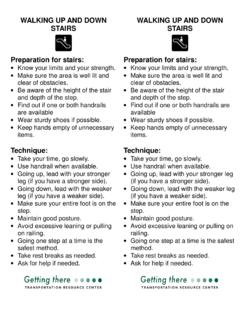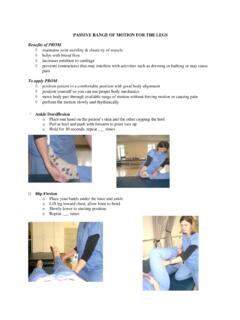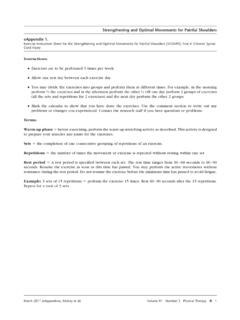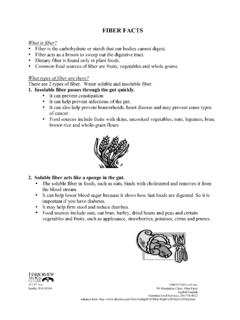Transcription of Skin Care & Pressure Sores
1 Copyright 2009 Model Systems Knowledge Translation Center (MSKTC).How can I tell if I have a Pressure sore? First signs. One of the fi rst signs of a possible skin sore is a reddened, discolored or darkened area (an African American s skin may look purple, bluish or shiny). It may feel hard and warm to the touch. A Pressure sore has begun if you remove Pressure from the reddened area for 10 to 30 minutes and the skin color does not return to normal after that time. Stay off the area and follow instructions under Stage 1, below. Find and correct the cause immediately. Test your skin with the blanching test: Press on the red, pink or darkened area with your fi nger. The area should go white; remove the Pressure and the area should return to red, pink or darkened color within a few seconds, indicating good blood fl ow. If the area stays white, then blood fl ow has been impaired and damage has begun. Dark skin may not have visible blanching even when healthy, so it is im-portant to look for other signs of damage like color changes or hardness compared to surrounding areas.
2 Warning: What you see at the skin s surface is often the smallest part of the sore, and this can fool you into thinking you only have a little problem. But skin damage from Pressure doesn t start at the skin surface. Pressure usually results from the blood vessels being squeezed between the skin surface and bone, so the muscles and the tissues under the skin near the bone suffer the greatest damage. Every Pressure sore seen on the skin , no matter how small, should be regarded as serious because of the probable damage below the skin surface. Stages of Pressure Sores [Also see Stages of Pressure Sores : Illustrations. ]STAGE 1 Signs: skin is not broken but is red or discolored or may show changes in hardness or temperature compared to surrounding areas. When you press on it, it stays red and does not lighten or turn white (blanch). The redness or change in color does not fade within 30 minutes after pres-sure is removed. What to do: Stay off the area and remove all Pressure ; keep the area clean and dry; eat adequate calories high in protein, vitamins (especially A and C) and minerals (especially iron and zinc); drink more water; fi nd and remove the cause; inspect the area at least twice a day; call your health care provider if it has not gone away in 2-3 days.
3 Healing time: A Pressure sore at this stage can be reversed in about three days if all Pressure is taken off the site. skin care & Pressure SoresPart 3: Recognizing and treating Pressure Sores Spinal Cord Injury Model Systems Consumer InformationNorthwest Regional Spinal Cord Injury System Department of Rehabilitation Medicine University of WashingtonBox 356490 Seattle, WA 98195 this document: publication was produced by the SCI Model Systems in collaboration with the Model Systems Knowledge Translation Center ( ) with funding from the National Institute on Disability and Rehabilitation Research in the Department of Education, grant no. care & Pressure Sores , Part 3: Recognizing and treating Pressure SoresSpinal Cord Injury Model Systems Consumer InformationSTAGE 2 Signs: The topmost layer of skin (epidermis) is broken, creating a shallow open sore. The sec-ond layer of skin (dermis) may also be broken. Drainage (pus) or fl uid leakage may or may not be present.
4 What to do: Get the Pressure off, follow steps in Stage 1, and see your health care pro-vider right away. Healing time: Three days to three weeks. STAGE 3 Signs: The wound extends through the dermis (second layer of skin ) into the fatty subcutane-ous (below the skin ) tissue. Bone, tendon and muscle are not visible. Look for signs of in-fection (redness around the edge of the sore, pus, odor, fever, or greenish drainage from the sore) and possible necrosis (black, dead tissue). What to do: If you have not already done so, get the Pressure off and see your health care provider right away. Wounds in this stage fre-quently need special wound care . You may also qualify for a special bed or Pressure -relieving mattress that can be ordered by your health care provider. Healing time: One to four months. STAGE 4 Signs: The wound extends into the muscle and can extend as far down as the bone. Usu-ally lots of dead tissue and drainage are pres-ent.
5 There is a high possibility of infec-tion. What to do: Always consult your health care provider right away. Surgery is frequently re-quired for this type of wound. Healing time: Anywhere from three months to two years. SUSPECTED DEEP TISSUE INJURY * Purple or maroon localized area of discolored intact skin or blood-fi lled blister due to dam-age of underlying soft tissue from Pressure and/or shear. The area may be surrounded by tissue that is painful, fi rm, mushy, boggy, warm-er or cooler as compared to nearby tissue. Deep tissue injury may be diffi cult to detect in individuals with dark skin tones. Progression may include a thin blister over a dark wound bed. The wound may further evolve and be-come covered by thin eschar (scab). Progres-sion may be rapid exposing additional layers of tissue even with optimal treatment. UNSTAGEABLE * Full thickness tissue loss in which the base of the ulcer is covered by slough (dead tissue separated from living tissue) of yellow, tan, gray, green or brown color, and/or eschar (scab) of tan, brown or black color in the wound bed.
6 * From: Pressure Ulcer Stages Revised by National Pressure Ulcer Advisory Panel (2007). < >.Possible complications of Pressure Sores : Can be life threatening. Infection can spread to the blood, heart and bone. Amputations. Prolonged bed rest that can keep you out of work, school and social activities for months. Autonomic dysrefl exia. Because you are less active when healing a pres-sure sore, you are at higher risk for respiratory problems or urinary tract infections (UTIs) Treatment can be very costly in lost wages or additional medical expenses. SourceOur health information content is based on research evidence and/or professional consensus and has been re-viewed and approved by an editorial team of experts from the SCI Model Systems. AuthorshipThis brochure was developed by the SCI Dissemination Committee in collaboration with the Model Systems Knowledge Translation Center. Portions of this document were adapted from materials produced by the SCI Model Systems.
7 The skin care and Pressure Sores series: Part 1: Causes and Risks of Pressure Sores Part 2: Preventing Pressure SoresSupplements: How to do Pressure Reliefs (Weight Shifts) Building skin Tolerance for Pressure Areas of the Body at High Risk for Pressure Sores Part 3: Recognizing and treating Pressure SoresSupplements: Stages of Pressure Sores : IllustrationsPage 2 of 2










